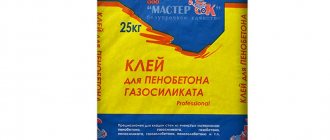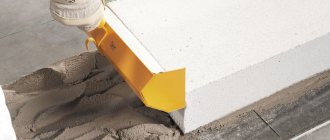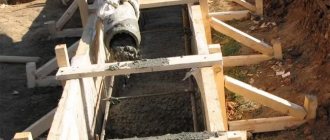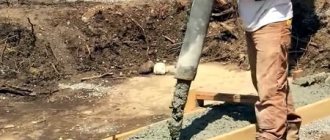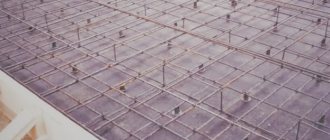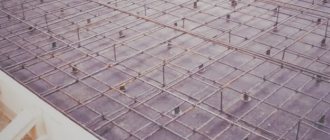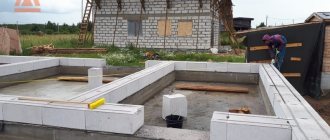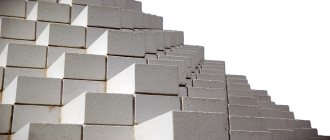An assessment of the required funds for the construction of a residential or non-residential private building requires a strict determination of the volumes of materials used during the work.
Today, one of the most popular and often used materials in the construction of load-bearing internal and external walls, as well as partition structures, is foam block. With today's technologies, an accurate calculation of the number of foam blocks can be achieved using two methods - using an online calculator or your own calculations. Although, of course, online calculations are simpler and more accurate, so we will talk about them further.
What is an online calculator for calculating the required number of foam blocks
Such a calculator is capable of calculating the required amount of material, as well as its parameters, which are most suitable for the construction of walls according to the individual numerical characteristics of the required structure.
Online calculation takes into account window and door openings, as well as when entering data on the availability of future facades. In addition to the number of foam blocks, the calculator will also display the recommended weight of the material, volume and cost of the required blocks. The results will also indicate the volumes of the required cement mixture that will be required to seal the joints, as well as the area of the required reinforcing mesh and other additional materials for construction work.
Quantity of foam concrete products per 1 square meter of masonry
Builders suggest that it would be wrong to ask the question: how many square meters are there in a foam block cube? The correct question should sound something like this: how much product should be purchased for a square meter of wall. Let's look at how many square meters of masonry can be obtained from m3 of building material. It’s very easy to calculate, especially using these instructions:
- We calculate the volume of one building product.
- We determine the width of the wall based on our project.
- We calculate 1 square meter of masonry.
- The cubic capacity of 1 square meter of wall is divided by the volume of one foam block product.
- We receive a piece quantity of the product per 1 m2 of masonry.
Now that we know the cubic capacity of the material we need, it’s easy to obtain the quantity of the product to build the wall.
Standard sizes, density and brand
When choosing blocks, be sure to take into account that the same sizes can be of different brands. To calculate, you need to take into account the density, which is indicated by the letter D. This indicator determines how much a cube of material will weigh.
The most convenient material for construction, foam concrete, is easy to calculate, so when buying a block product, you must definitely learn how to calculate the amount of foam block in a cube.
Features of working with the calculator
In order for the resulting calculation result of the online calculator to be as accurate as possible, you will need to carefully fill out all the required data.
Initially, you should decide on the parameters of the future material - its size and density. Next, you should fill in the fields for the given values of the dimensions of the future building in terms of length, height and estimated thickness of the future walls, as well as information about existing materials (characteristics of the thickness of the cement mortar, data on the frequency of the reinforced mesh). If you know the price for one foam block, online calculation will easily determine how much the foam block costs.
Designation of calculation results
As soon as all the data is specified, after clicking on the calculation button, the online calculator will display the following values:
Data on the perimeter of the future building - they will indicate the exact length of each wall of the future building in view of the specified data on the thickness of the foam blocks;
Values for the total area of masonry - the data will be indicated taking into account door and window openings;
Indication of the thickness of future walls - the calculator will show data taking into account the type of masonry, as well as the characteristics of cement joints depending on their thickness;
The value of the total number of foam blocks is the number of blocks required for the construction of a building individually;
Total mass of foam blocks - data without indicating the weight of auxiliary materials used for construction (mesh for masonry, cement mortar); Required mortar for the entire masonry - data on the quantity and volume of cement mortar for sealing connecting joints;
The value of the number of rows with the count of connecting seams - the data does not include the presence of a pediment;
The value of the amount of required reinforced mesh - the calculation is made taking into account the laying of reinforced mesh on each row of a row of foam blocks;
Designation of the approximate weight of future finished walls - the data is indicated taking into account all blocks, cement joints and masonry mesh;
The load of future walls on the foundation structure is a value that allows you to determine the type and density of the foundation. The calculation does not assume the weight of the roof and the use of materials for finishing and insulation.
The calculator will also help determine the required volumes of building materials for the construction of partitions between rooms. To do this, you must enter the data again with the partitions parameter.
Help for the stronger sex: selection of T-shirts and T-shirts
T-shirts and tank tops are present in every man's wardrobe. They are worn at any time of the year, so they always remain relevant.
At first glance, it may seem that there is nothing difficult in choosing a T-shirt, but with the onset of warmer months, many models with a wide variety of styles appear in stores, which makes even experienced shopaholics get confused. List of categories: Date: 04/12/2015 Comments: Rating: 46C Every year, more and more often, in the construction of residential and agricultural buildings, a material such as foam block is used. This is due not only to its excellent performance characteristics, but also to the fact that all construction work can be done independently. At the same time, it is very important to calculate the consumption of building materials, which will allow you to assess your financial capabilities and minimize cash costs. Therefore, you need to understand how to correctly calculate the number of foam blocks for the construction of a particular facility. Advantages of foam blocks.
Initial data required for the calculation
To calculate the amount of building material required to build a house, you need to know:
- thickness of external walls and partitions; perimeter and height of masonry; number and dimensions of window and door openings; block sizes.
The standard dimensions of foam blocks are 60x30x20 cm.
For this material, like for brick, the sides are named identically: spoon (20x60 cm), poke (20x30 cm) and bed (30x60 cm).
Thanks to these names, it is easier to determine the type of masonry (Fig. 1). Single stone masonry means that the building material will be mounted on a bed with pins directed towards the outer and inner sides. Typically, such structures are erected in the northern regions of the country, as they are quite durable and warm.
Picture 1.
Names of the sides of the foam block. Installation in half a stone involves laying blocks on a bed, with the pokes directed along the walls. This method of masonry is used more often than the first option, since in this case the material consumption will be significantly less. Even less stone is consumed for laying ¼ stone, but this installation method is mainly used for creating partitions and for constructing agricultural utility rooms. To correctly calculate the number of foam concrete blocks, the walls of the future house must be divided into groups according to the type of masonry used.
For example, the first group is external walls, the second is internal load-bearing, the third is non-load-bearing partitions. After this, the total length of the walls in each group and the total area of windows and doors are calculated. Then the volume of materials in each group is calculated, with the exception of the sizes of windows and doors. At the last stage, the total volume of foam blocks required for the construction of a house is summed up. Return to contents An example will be given of a situation where it is necessary to calculate foam blocks for the construction of a two-story house. Initial data: dimensions of the building - 8x9 m; height of the 1st floor - 2.5 m; height of the 2nd floor - 2.3 m; thickness of the external walls of the house - 30 cm (half stone masonry is used); thickness of the partitions - 20 cm (half stone); length of the partitions on the 1st and 2nd floors - 8 m each. Table of foam block sizes. First you need to calculate how much building material will be used to construct the walls of the 1st floor. To do this, the perimeter of the building is multiplied by the height and thickness of the masonry: (8+8+9+9)*2.5*0 .3 = 34*2.5*0.3 = 25.5 m3.
The volume of one block is: 0.6*0.3*0.2 = 0.036 m3. Therefore, for the construction of external walls of the 1st floor you need: 25.5 / 0.036 = 708 pcs. From the obtained value, you can calculate the blocks that will be in window and door openings, but this may not be done, because these elements may be needed in as spare parts. The calculation of material for the 2nd floor of the house is carried out according to the same scheme: 34 * 2.3 * 0.3 = 23.46 m3. In pieces it will be: 23.46/0.036 = 652. Next, you should calculate the number of blocks required for the construction of partitions: for the 1st floor: 8 * 2.5 * 0.2 = 4.0 m3; for the 2nd floor floors: 8*2.3*0.2 = 3.68 m3; total volume of blocks for partitions: 4.0+3.68 = 7.68 m3; number of foam blocks for partitions (in pcs.): 7.68/ 0.036 = 213. Therefore, for the given example it is necessary to purchase: 25.5 + 23.46 + 7.68 = 56.64 m3 of foam blocks (or 1573 pcs). A special glue is excellent as a mounting solution for laying foam concrete blocks, the consumption of which is approximately 25 kg per 1m3.
Therefore, for the task at hand you will need: 25 * 56.64 = 1416 kg of adhesive mixture. Have you decided to build a house from foam blocks, but don’t know how much you need to purchase? What factors should you rely on when choosing, and what should you be guided by? Then this article is just for you. Let's figure out how much foam block is needed for a house, taking into account the characteristics of the material, the region in which construction is being carried out and the type of product. Finished structure
Product size
Using the table, let's look at some types of products, depending on their purpose, and find out their standard sizes.
Table 1. How many foam blocks are needed to build a house: choose the dimensions:
Type of block Its size and brief description Wall It is used, as the name suggests, in the construction of building walls. The standard is a length of 60 or 62.5 cm, the width can be 40, 30 or 50 cm, and the height is 20, 25 or 30 cm. Partition It is used when installing partitions.
Its length is the same as the wall one, but the width and height are different. The first value can be 25 or 30 cm, and the second - 8, 9, 10, 12, 15 cm. U-shaped Its application boils down to the following: it can be a stationary formwork, partition or other structure. The size range is indicated in the photo. With cladding For In order to save yourself from the need to cladding the building from the outside, you can use products that have a cladding side when constructing a building. Their dimensions are the same as those of the wall block.
Dimensions
On a note! The dimensions indicated in the table are the most common among manufacturers and popular among developers. But this does not mean that other sizes cannot be used. In accordance with the state standard, manufacturers can produce products of other parameters by agreement with the buyer.
Calculation of the volume of foam blocks
The foam block parameters are indicated in the proportion: width x height x length
Foam block 200x200x400
Volume: 0.016 cubic meters
Quantity per cube: 62.5 pieces
Foam block 200x300x400
Foam block volume: 0.024 cubic meters.
Quantity per cube: 41.7 pieces
Foam block 100x300x600
Foam block volume: 0.018 cubic meters.
Quantity per cube: 55.6 pieces
Foam block 125x300x600
Foam block volume: 0.023 cubic meters.
Quantity per cube: 43.5 pieces
Foam block 150x300x600
Foam block volume: 0.027 cubic meters.
Quantity per cube: 37 pieces
Foam block 200x300x600
Foam block volume: 0.036 cubic meters.
Quantity per cube: 27, 7 pieces
Foam block 250x300x600
Foam block volume: 0.045 cubic meters.
Quantity per cube: 22, 2 pieces
Foam block 300x300x600
Foam block volume: 0.054 cubic meters.
Quantity per cube: 18.5 pieces
Foam block 200x400x600
Foam block volume: 0.048 cubic meters.
Quantity per cube: 20, 8 pieces
Foam block 300x400x600
Foam block volume: 0.072 cubic meters.
Quantity per cube: 13, 8 pieces
Calculation of wall thickness
So, since we are going to figure out how much foam block is needed to build a house, we need to calculate the thickness of the wall of the future building. To do this, we need to know exactly some indicators, or, more precisely, their values.
It's worth finding out:
- Thermal conductivity coefficient of the base material used for masonry; Its specific gravity; Heat transfer resistance coefficient; What material will be used as insulation; Its thermal conductivity coefficient will also be needed.
Let's pretend that:
- Our product will have a specific gravity of 500 kg/m3; Its thermal conductivity will be about 0.15 W*mS; When choosing insulation, we will give preference to mineral wool, the thermal conductivity of which will be about 0.05 W*mS;
Thermal conductivity of some insulation materials
- Heat transfer resistance can have different values - it is individual for each individual region. The values are indicated in SNiP; We will take as a basis the average indicator - 3.3.
Heat transfer resistance
Let's move on to the calculations:
- From the value of resistance to heat transfer, we subtract the same value of mineral wool, which we will use when insulating the structure: 3.3-0.05 = 3.25; Multiply the thermal conductivity of the blocks and the indicator of resistance to heat transfer: 3.25 * 0.15 = 0.4875 . Taking into account rounding - 0.49; That is, when erecting a building using a block with a density of D500 and a thermal conductivity coefficient of 0.15, the minimum wall thickness will be 49 cm.
Note! If we use a product of higher density, the result may change significantly.
Indeed, as this indicator increases, thermal efficiency decreases. If you perform more intensive insulation, then the thickness of the wall can be reduced to 40 cm. In this case, you can build a wall in one block 400 mm wide.
Before you calculate how many foam blocks are needed for a house, you need to decide on the type of masonry. The material can be laid in one, two, one and a half or half blocks. Take a look at the photo below which shows some of the possible options.
Types of masonry
Classification based on application
Let's use the table.
Table 2. How to calculate how many foam blocks are needed for a house: select the type of material in accordance with its specific gravity:
Area of use Suitable material Sound and heat insulation, frame filling If you are interested in these areas of application, then pay attention to the material called thermal insulation. It is available both in liquid form and in product form. Specific gravity is low, as is thermal conductivity.
It was these factors that predetermined the purpose. Low-rise construction: construction of walls, interior partitions. In this case, purchase structural and thermal insulation material. Its specific gravity will be sufficient for the construction of a building of 1-2 floors, while the thermal stability is at the proper level. Above we looked at an example of a calculation, assuming that this particular type of product will be used. Construction of structures of 3-4 floors, the use of heavy floors. If you want to build a building with more than 2 floors or will use heavy floors (there are a lot of examples you can give), then turn your attention to the most durable blocks. However, keep in mind that their thermal efficiency is much lower. This means that you will have to intensively insulate the building in order to preserve the ability of the walls to retain temperature.
This is interesting! In addition to the types described above, there are even more durable blocks. They are called structurally porous.
The demand for them is extremely low, which is why mass production has not been established. However, you can purchase them by making an individual order. The specific gravity of such material reaches 2000 kg/m3.
Options
Structural parts with densities D900 and D1200 are characterized by high strength and weight. Thermal insulation elements D500-900 are used in the construction of 3-story buildings with walls laid in 1 layer.
Thermal insulation products of the D400 and D500 brands are used when arranging partitions inside structures. Aerated concrete blocks differ in configuration. The walls are laid from standard type products, and reinforced beams made of foam concrete are used to construct the ceilings.
READ How long does Victor Reinz Reinzosil sealant take to dry?
Such products are durable, reliable in operation, and designed for maximum permissible loads. Installation of floors is carried out from T-shaped structures with parameters 600x250x200 mm.
Product geometry
Now it will be relevant when choosing products to pay attention to their possible geometry. In this case, we will rely on this from GOST for cellular concrete.
Table 3. How to calculate how many foam blocks are needed for a house: select a category:
Category number Comments First Has almost perfect geometry. In accordance with the requirements, they should not exceed 1-1.5 mm. Such blocks should be used in the construction of a residential building. Their advantage is that when laying, it is possible to maintain the minimum thickness of the masonry joint, which will significantly reduce the number of cold bridges and, as a result, increase the level of heat retention of the walls. As a result, the developer will save not only on the purchase and installation of insulation, but also on heating finished structure in the cold season. Second The deviations for such products are somewhat greater.
They can reach 2-3 mm. Laying can be done either with glue or with mortar. Here you need to realistically assess the situation and carefully examine the products. If there are too many chips, and the differences in size are visible to the naked eye, then you should still choose a solution, since the glue consumption will be too large, which will incur unjustified costs. Third Deviations can reach 1 cm.
It is not recommended to use such blocks for housing construction at all. But it is quite possible to build a shed or other outbuilding. Laying is carried out exclusively using cement-sand mortar. The price of such products is much lower.
What else needs to be taken into account when calculating wall material?
Having made preparatory calculations and found out how many foam blocks are in 1 cube, you can safely take wall material in the amount that ultimately came out. But, if you take into account the fact that you will need to pay a large amount for one artificial stone, you have to think about austerity.
Stone laying is carried out using a mortar, the choice of which determines the thickness of the layer:
- cement-sand mortar – 1-2 Washing machine;
- adhesive composition – 2-3 mm.
Therefore, it is reasonable to make more painstaking calculations to find out how many foam blocks with cement-sand mortar are in 1 cube, because when using an adhesive composition, the small thickness of the layer will not be able to particularly influence the amount of wall material. We advise you to look through the article and find out what solid foam concrete is.
Fundamentally! Also, when building a house, you should know how many meters of area are in 1 cubic meter of foam blocks.
In order to calculate the area of a stone, you need to multiply the height by the length and you get the figure sq. m:
- Foam concrete measuring 600 x 300 x 200 mm has an area of 0.18 sq.m.
- If one wall of the house is 27 square meters. m (3 x 9), then you can calculate the amount of stone using the formula: 27/0.18 = 150 units, respectively, in cubic meters the figure will be 150x0.036 = 5.4 cubic meters. m.
Knowing all the options for calculating wall material, you can choose a more successful method or use several to make sure the obtained result is correct. The necessary indicators are the thickness of the wall and the solution layer. Read how to transport concrete products here.
Existing calculation methods
You can calculate the amount of material using certain methods, there are several of them:
- On the Internet you can find quite a few options for various calculators located on specialized sites about construction or websites of manufacturing companies. To get the result, you will need to enter certain data and the more there is, the more accurate the calculation will usually be. Usually these are: wall area, masonry height, wall thickness, thermal conductivity of products, and so on.
Minus – Data may differ when using different calculators.
Screenshot
- Applications are analogues of calculators. They can be installed on mobile devices or PCs. The calculation is carried out according to the above principle using the data you specified.
The downside is that such applications are often not fully developed, so the data may be partially or completely untrue.
Sample Application
- The most reliable method is to use the services of specialized companies or private specialists. The calculation will be as accurate as possible.
The downside is the high cost of the service. Additional costs will be required.
Collaboration with an engineer
- A moderately reliable, and, most importantly, free method is self-payment. If you do everything right, the result will be correct. The main thing is to accurately find out the source data and avoid mistakes in the calculations.
We count ourselves
Method for independently determining the number of products
Now we proceed directly to the calculations using the example of a building measuring 10*10 meters.
Table 4. How many foam blocks are needed for a 10x10 house:
Let's decide on the size. As we have already said, the size of our future building will be 10 * 10 meters. This is what we will build on.
Using the following actions as an example, you can easily repeat them for any size of building. The height of the masonry will be standard 3.0 meters. We will not count partitions, since this is done according to a similar principle. Their location and quantity are indicated in the plan that is attached to design of the house. Perimeter and area P = 10 * 2 + 10 * 2 = 40 meters. Area: 40 * 3 = 120 m3. This is the area of all walls. Window and door openings Their total area must be subtracted. Let's assume that we have windows there will be 5, and doors – 2. The area of one window will be 1.5 m2, and the door will be 2.1 m2.1.5*5=7.5 m2;2.1*2=4.2;4.2+ 7.5 = 11.7 m2; 120-11.7 = 108.3 m2. For the construction of such an area we need a block. Select a product Let's assume that we purchased a product with dimensions 625 * 500 * 300, accuracy category - 1, specific weight - 600 kg m3. If the product is laid at 500, then this wall thickness will be sufficient if we are building in the middle region (heat transfer resistance coefficient is 3.4). You can easily verify this by calculating it by analogy (discussed above). Amount of foam concrete material Area: 0.625 * 0.5 = 0.1875 m2. 108.3 / 0.1875 = 577.6 pieces How many foam blocks are needed for a 10x10 in house cubes? Volume: 0.625*0.5*0.3=0.09375 m3.1\0.09375=10.6 pcs. 577.6/10.6=54.49 m3. Taking into account rounding – 55 m3.
Note! When purchasing material, keep in mind that some of it may be damaged during transportation or directly during the construction of the building. Therefore, blocks should be purchased with a margin of approximately 5%.
Minimum stock
It is necessary to make a reserve for several reasons. Small errors may be made when making calculations; 3-5% of additional purchases are added for these errors.
In addition, 2-3% is purchased based on defects that can be obtained during loading, transportation and unloading.
Considering how many foam blocks are 200 300 600 in 1m3, you can consider whether to add a small amount to get a fully packed pallet, or whether the stock allows you to miss a few pieces so as not to overpay for an almost complete package.
Pallets of different sizes will help you make a more accurate choice.
Adhesive composition and tools
In addition to the block itself, to start work you will need to purchase an adhesive composition or raw materials for mixing the solution. It depends on what material you chose for the masonry.
Masonry adhesive
To do the work yourself, you will need the following tools:
Level
Rubber hammer
Square
A thread
Armature
- Wall chaser (manual or electric);
Power tools
For cutting
- Notched trowel or ladle for applying the mixture;
To apply the mixture
- To prepare the solution - a concrete mixer;
Concrete mixer
- When mixing glue, use a container for it;
Container for preparing glue
To mix the mixture
Approximate calculation of the cost of a house box
Brief instructions:
- Let's assume that we need to purchase 55 m3 of blocks, which corresponds to our above calculations. The average market cost of a cube is 3,400 rubles. 55 * 3,400 = 187,000 rubles. According to manufacturers, glue consumption, with ideal block geometry, will be 1 25 kg bag per 1 m3 of masonry . We will realistically assess the situation and assume that 1 m3 of masonry will require 35 kg of glue. 55 * 35 = 1925 kg of dry mixture. If you buy 25 kg bags, then: 1925/25 = 77 bags. Tools will cost about 20 thousand rubles. 1 bag of glue costs on average 170 rubles. 77 * 170 = 13090. 13090 + 20000 + 187000 = 220090. If you do the work yourself, then no other expenses are expected.
We calculate the cost
And the video in this article will briefly describe the stages of the work. This information will be useful for any developer whose choice has fallen on foam blocks.
How many gas blocks will fit in 1m3?
Porous concrete is available in various types and configurations. Partition products are used in construction. The amount of aerated concrete in 1 m3 depends on the parameters. In 1 cube of foam blocks measuring 600x50x250 mm, 133 pieces are placed, 600x125x250 mm - 96 pieces, 600x300x250 mm - 40. If the construction project will be carried out independently, then you need to calculate the need.
1 square requires 5 products. They are easy to process and can be easily installed when installing utility lines. Porous products are characterized by seismic resistance and strength.
Sources:
https://openoblokah.ru/raschyet/33-skolko-penobloka-v-1-kube https://2bloka.ru/skolko-penoblokov-200-300-600-v-kube.html https://stenovoy. ru/faq/show-56.htm https://www.budportal.com.ua/articles/skolko-penoblokov-v-kube https://1beton.info/vidy/gazobeton/skolko-shtuk-penoblokov-v- 1m3-300-h-200-h-600-gazoblokov-gazobetona-v-1-kube
Is it worth giving preference to this material at all?
Are you sure that this material is what you need? Let's take a look at the main set of advantages and disadvantages.
Advantages:
- High thermal efficiency will make the building truly warm. The coefficient is 0.08-0.33 W*mS. The material in question is one of the three leaders in this regard among representatives of lightweight concrete.
Compared to competitors
- High durability and frost resistance. In practice, this has not yet been verified. However, there is also no reason not to trust manufacturers.
The concept of frost resistance
- Strength and density allow the material to be used in many areas of construction. In the article we looked at the corresponding classification and were completely convinced of this.
Specifications
- Environmental friendliness is due to the composition of components that are not capable of causing harm. The foam block contains: water, cement, sand, lime and foaming agent. There are also additives that are individual for each manufacturing company.
Compound
- Fire resistance is substantiated by GOST.
Fire resistant
- Easy to process. The product can be easily split, sawed, sanded, and so on.
cutting
- Large dimensions will speed up the construction process.
Dimensions
- Low weight – reduced load on the foundation of the structure.
Weight
Low price
- Soundproofing ability and vapor permeability. The latter quality will help to establish the most comfortable climate in the building.
Soundproofing comparison
Range
- Biological stability. Fungus and mold are not scary.
How to calculate how many foam blocks are needed for a house
- Possibility of self-production.
Self-production
- Simplicity of installation technology.
Laying
Minuses:
Fragility. Be careful and careful when transporting and carrying out work. Poor resistance to tearing. The need to purchase special hardware for fixation. Presence of handicraft production.
This fact increases the likelihood of purchasing products of inadequate quality. Hygroscopicity. Moisture absorption reaches 15%. And, despite the pore structure, which is closed, the value is relatively large.
This means that the developer must approach the cladding of the building as responsibly as possible. It must be performed technically correctly. If products are not protected from moisture, they will eventually be destroyed by moisture.
- Shrinkage. Walls may crack.
How many pieces of foam blocks in 1 m3 (300 x 200 x 600): aerated concrete blocks (aerated concrete) in 1 cube
The technology of construction from aerated concrete blocks corresponds to trends in energy saving and environmental friendliness. Cellular concrete is produced using additives that provide a porous structure. When choosing, pay attention to types, parameters, volume.
There are two types of gas blocks
Porosity, which depends on production technology and additives, determines the properties of building elements. Foam concrete is produced using autoclave and non-autoclave methods.
The working mixture consists of the following components:
- lime;
- cement;
- aluminum powder;
- quartz sand
- gypsum;
Mixing the ingredients and filling the molds is carried out using standard technology. The difference between the materials lies in the drying method. Autoclaved concrete matures in special chambers, while the other type matures in natural conditions.
As a result of autoclave processing, the building material acquires strength and resistance to low temperatures. This production technology provides automatic control, which allows you to set the necessary parameters in advance.
Materials made using various technological processes are slightly different, but are characterized by a number of advantages:
- low price;
- excellent insulating properties;
- easy to cut and saw into pieces and according to a given configuration;
- fire and environmental safety;
- biological stability;
- maintaining original properties for 100 cycles;
- lack of ability to rot.
Insulation parameters depend on the brand of concrete used. When choosing, it is recommended to take into account the requirements of technical and construction standards. For walls with a thickness of 350-450 mm, aerated concrete grade D400-500 is chosen.
For the construction of external and load-bearing walls, autoclaved building elements of grades D500-600 are used, which are characterized by increased density. The material is used for the construction of objects in any climatic conditions. For laying internal walls, D400 brand products are used, which retain heat.
Aerated concrete blocks can withstand the load of floor slabs. The material does not require additional treatment with antiseptic compounds; according to SNiP standards, the noise insulation index is in the range of 41-60 dB.
U-shaped products are produced with the following parameters
This type of building elements is used to construct monolithic stiffeners. The internal space is filled with concrete and reinforcement. The U-shaped blocks are 25 Washing machine high, 50-60 Washing machine long, 20-40 Washing machine wide. Building elements are used in laying openings and securing floor slabs.
